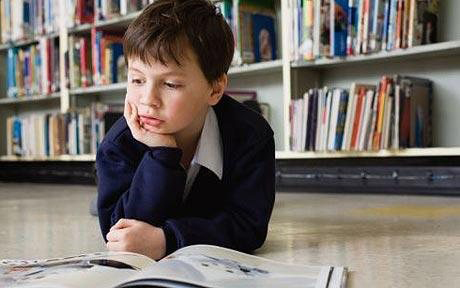2 Moving from the early years to primary
You are now going to consider how literacy and reading are taught in primary schools. In 2006, the Rose Review of reading in the Early Years Foundation Stage and Key Stage 1 emphasised the importance of the development of literacy skills in preparing children in Reception and Year 1 of primary school.
The report emphasised the importance of literacy skills in laying the foundations for more structured approaches to reading in primary schools, such as phonics, an approach that breaks words into parts that represent separate sounds. The clear distinction between ‘literacy’ and ‘English lessons’ was made in Section 11 of the Rose Review (2006). Literacy skills are much broader and encompass speaking and listening across all of the curriculum.
The National Curriculum and the National Literacy Strategy
11. A distinction needs to be made between literacy and English. Literacy skills, that is, reading and writing (and the skills of speaking and listening on which they depend), are essential Cross-curricular skills: they are not subjects and are not confined to English lessons.
Learning support workers play a key role in speaking and listening to children and in so doing can make an important contribution to the development of these literacy skills, including reading, in all areas of the curriculum.
This section is designed to give you some ideas that you might like to try out in your own setting. You will use a case study to examine the attempts of one teacher to introduce an innovative approach to reading and to reflect on how this has helped to address the gender gap in her school.
The challenge of encouraging children to read is a big one because it is a fact that in England the weakest readers at age 10 are seven years behind the strongest. Children in the poorest families are the ones most unlikely to be able to read at age 11 because there is a tendency for them to come from families of lower socio-economic status and therefore may have less access to books and reading within the family (Ward, 2014).
Activity 3
Read the adapted extract below from the TES (Times Educational Supplement) online about the ‘reading gap’ in primary schools and then answer the questions that follow.
Campaign to end ‘shameful’ reading gap in primary schools
Figure 2 Child reading a bookAround 1.5 million children will leave primary school struggling to read by 2025 unless urgent action is taken, according to new research published today by a campaign group set up to eradicate illiteracy.
The report published by Save the Children, on behalf of the Read On Get On campaign, shows that England is one of the most unequal countries in Europe when it comes to children’s reading. [This inequality in reading ability has been referred to as the ‘reading gap’.]
The research suggests the UK economy could be £32bn worse off without action being taken to ensure 11-year-olds leave primary school as more competent readers.
In England, the weakest readers at age 10 are seven years behind the strongest – only Romania has a greater gap. And it is children in the poorest families who are the most likely to be unable to read well by the age of 11, says the charity.
The Read On Get On campaign, a coalition of charities, businesses and educationalists, is calling on all political parties to pledge to support the ’bold but achievable’ target of making sure every child born this year is able to read well by the time they leave primary aged 11 in 2025.
[…]
Last year, two in five children [Tip: hold Ctrl and click a link to open it in a new tab. (Hide tip)] eligible for free school meals did not reach this level by the time they left primary school, compared to just one in five of those not on free school meals.
‘In Britain, primary education for children has been compulsory for at least the last 150 years,’ said Dame Julia Cleverdon, former chief executive of Business in the Community and chair of the Read On Get On campaign in the foreword to the report.
‘Yet to our shame, thousands of children leave primary school each year unable to read well enough to enjoy reading and to do it for pleasure, despite the best efforts of teachers around the country.’
The report compares the challenge to the eradication of polio and cholera, pointing out it is possible but only with high ambitions and long-term sustained action.
It calculates that if all primary schools were to improve at the same rate as the top 25 per cent, then by 2025 around 97 per cent of pupils would be reading well.
Russell Hobby, general secretary of heads' union the NAHT, said teachers were making impressive progress but universal literacy would depend on broadening the challenge beyond schools.
[…]
Justin Forsyth, chief executive of Save the Children, said: ‘Read On Get On is not just about teachers, charities and politicians – it’s about galvanising the nation so that parents, grandparents and volunteers play their part in teaching children to read.’
The campaign is calling on parents to read with young children for ten minutes a day, urges volunteers to sign up to help children with reading in their local school and calls on schools to lead the way locally.
- What do you think is meant by ‘the reading gap’?
- Why do you think the UK is so far down the international league tables?
Comment
From the TES extract you have just read, it appears that the ‘reading gap’ is linked to the inequalities in society. The reasons for this are complicated, but may include factors such as limited access to books in the family and parents not having the time or resources to read to children. If we are aware that there is a problem, we can work together to tackle the challenge.
This means parents, teaching assistants, teachers and all other support staff working together and sharing their expertise – in other words, you.
Two examples of positive action together are:
- The Read On Get On campaign, which aims to ensure that every child born today will read well by the age of 11 in 2025 and in which teaching assistants have a key role to play.
- A blog set up by a mum living in the USA, who shares her interest and expertise as a parent of a young child.
1.1 Developing language skills

